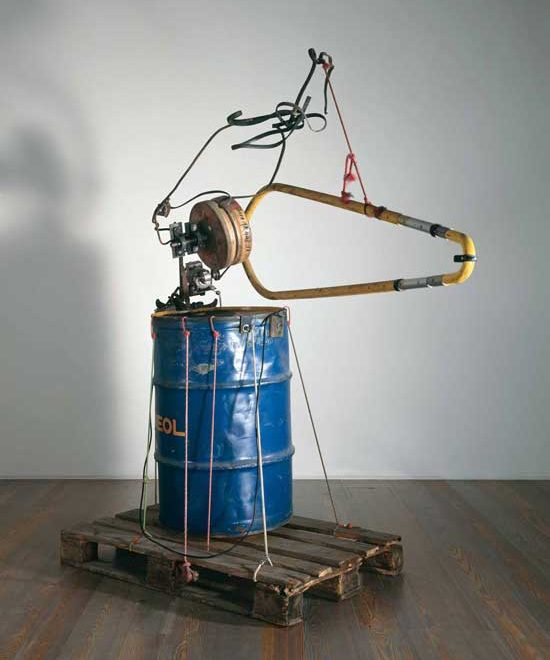Jean Tinguely
Retrospective
Jean Tinguely’s works are being shown for the first time in Spain. Seventeen years after his death, the Swiss iron sculptor and master of kinetic art is at the centre of a retrospective exhibition at the IVAM, Valencia. Born in 1925 in Fribourg, Jean Tinguely spent his childhood and youth in Basel. That is where he got his schooling and, during the Second World War, his training as a window dresser. After the war he worked as an independent decorator and drew attention to himself with his spectacular designs for various shops. At the same time he attended courses at the School of Arts and Crafts in Basel and learned to adapt the use of daily objects in art in accordance with the ideas of the Bauhaus. In 1952, Jean Tinguely and his first wife, Eva Aeppli, settled in Paris, where he rapidly fitted in with the artists’ crowd of the city. Tinguely created reliefs in which moveable white elements slowly rotated against a black background to create new compositions. These moveable images were entitled Méta-Malevich or Méta-Kandinsky and did in fact re-create the models of their titles in constantly new combinations. With the Méta-Matics, the drawing machines, in 1959, Tinguely met with his first successes with the public. Each visitor to an exhibition could use one of the artist’s machines to produce his or her own individual abstract drawing defined by the parameters of the machine, a concept that aroused great interest. Artists such as Hans Arp or Marcel Duchamp reacted positively and recognized the new path that Tinguely had opened up in art. The sixties saw the creation of large-scale sculptures made of scrap iron before Tinguely began to paint his sculptures a uniform black. It was now not so much the material itself or the fact that it came from a scrap heap that was given prominence, but rather the uniform sculptural effect. Movement that actually extended beyond the sculpture (and that was doubled in the water sculptures) was an integral part of the work. Monumental works such as Hon (She), 1966, or Le Cyclop (The Cyclops), from 1969 on, were conceived in collaboration with other artists. Tinguely always worked together with his artist colleagues; Niki de Saint Phalle, Bernhard Luginbühl, Yves Klein and Daniel Spoerri were some of his important partners in art. The idea of artistic collaboration was central and essential to Jean Tinguely. The artist enjoyed collaborating with his artist friends on various occasions, not only on sculptures but also on productions for the theatre and exhibition concepts. The seventies and eighties saw the creation of monumental sculptures such as the installation Grosse Méta Maxi-Maxi Utopia (Great Meta Maxi-Maxi Utopia), which he built in 1987 for the retrospective at the Palazzo Grassi in Venice. Further exhibitions of his machine sculptures were held throughout Europe, at the Tate in London, the Centre Georges Pompidou in Paris and the Kunsthaus Zürich. Tinguely met with major success, as attested to by the public commissions he received – such as for the Fontaine Igor Stravinsky (Igor Stravinsky Fountain), which he built in 1983 with Niki de Saint Phalle for the square adjacent to the Centre Georges Pompidou. After Tinguely’s death in 1991, his widow Niki de Saint Phalle came to an agreement with the healthcare firm of Roche in Basel by which the firm founded a museum and assured its running costs. In exchange, she made a donation to the museum from the artist’s estate. The Museum Tinguely was inaugurated in October 1996, its costs entirely financed since then by Roche.



